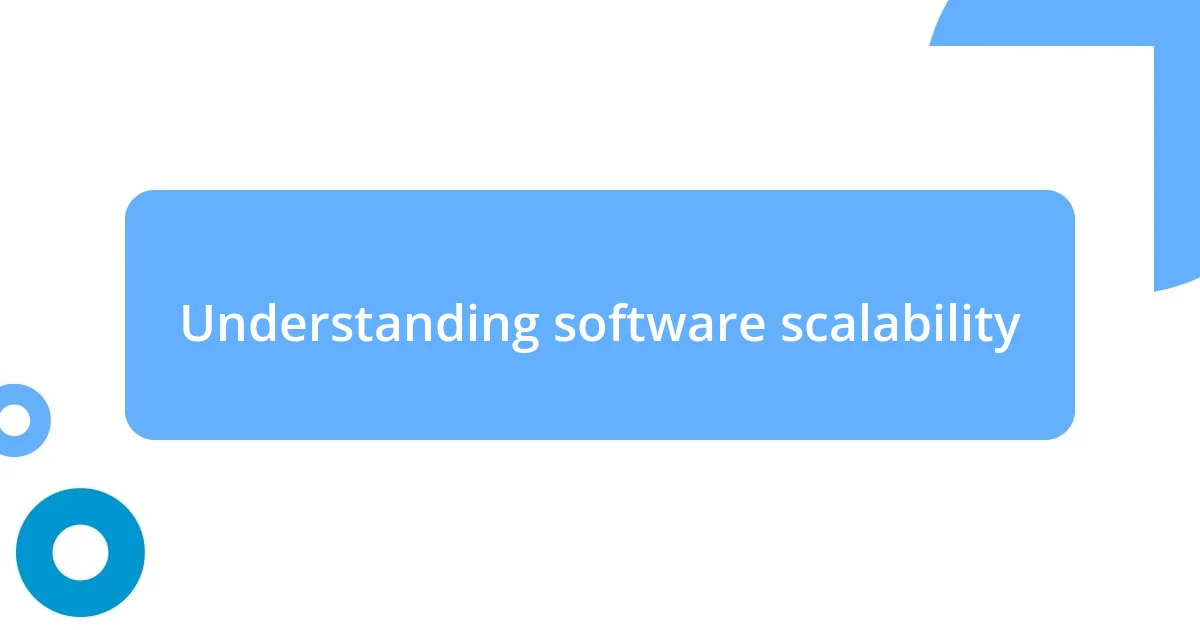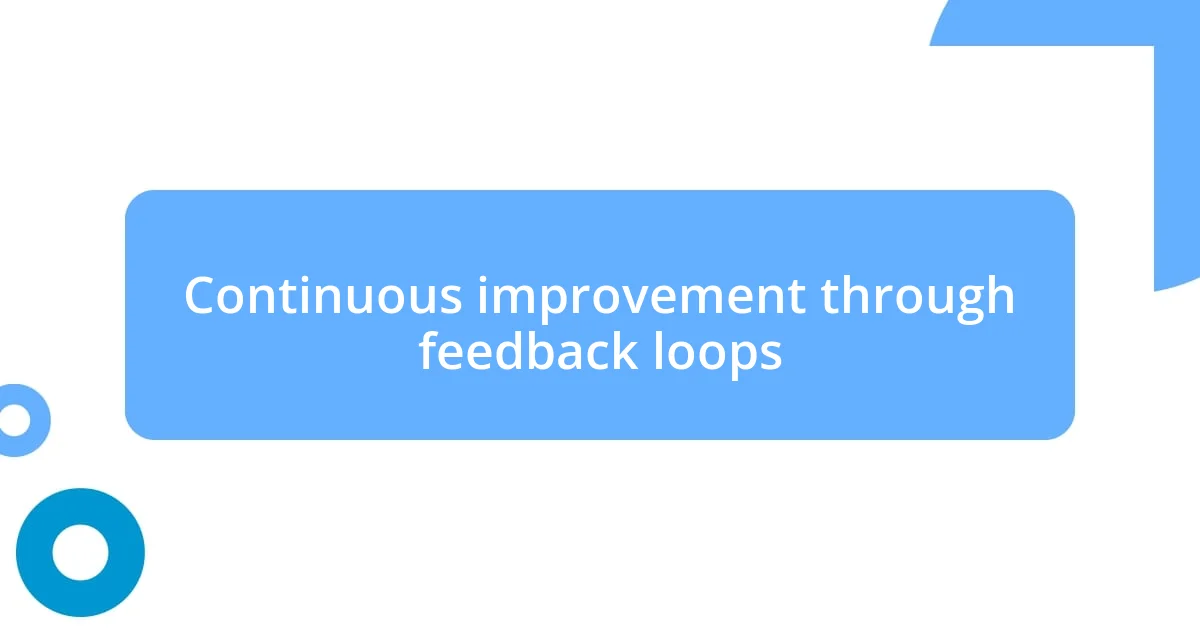Key takeaways:
- Software scalability is critical for handling increased loads and maintaining user trust; it requires early planning and robust architecture.
- Implementing techniques like load balancing and caching, along with effective monitoring, significantly enhances system performance and resource optimization.
- Continuous improvement through user feedback and team collaboration fosters a culture that drives scalability and enhances overall project success.

Understanding software scalability
Software scalability is essentially the ability of a system to handle increased load without compromising performance. I recall a project where we underestimated traffic loads, and the system began to lag under pressure. It was a wake-up call for me—ensuring that a platform can grow seamlessly is critical, not just for functionality, but for user trust.
When I think about scalability, I often reflect on the analogy of a balloon. Initially, it can hold a small amount of air, but as you blow into it, it expands to accommodate more. Isn’t it fascinating how this mirrors software systems? The better your architecture, the more air—or users—you can effectively support. I’ve found that building a flexible system from the ground up makes a world of difference in how it performs under pressure.
Another vital aspect of scalability is planning for growth right from the initial stages. I’ve seen too many teams focus solely on immediate goals and then scramble for solutions as user demand increases. It raises an important question: are you setting yourself up for sustainable growth, or are you just focusing on short-term wins? In my experience, integrating scalability into the design process is non-negotiable if you want to avoid future headaches.

Importance of scalable architecture
Scalable architecture isn’t just a technical requirement; it’s a foundation upon which a successful software application is built. I vividly remember a startup where I worked that implemented a scaled-back design early on, thinking they could optimize as they grew. It caught up with us eventually, and the stress of retrofitting a system meant for a handful of users to accommodate thousands was overwhelming. That experience taught me that investing in scalable architecture is not just an option—it’s essential for long-term viability.
- Enhanced Performance: A scalable system can maintain performance even under increased loads, ensuring users don’t experience lags or downtimes.
- Cost Efficiency: Proper scalability reduces the need for costly overhauls and system replacements in the future.
- User Satisfaction: As systems grow, user expectations increase; scalable architecture helps in meeting and exceeding those expectations.
- Flexibility for Innovation: A well-architected system allows for easy integration of new features without compromising existing functionality.
- Adaptability to Change: In today’s fast-paced environment, scalable systems can adjust more readily to shifting business needs or market conditions.
Emphasizing these aspects during the design phase provides a roadmap not only for current requirements but also for future growth. When I reflect on my professional journey, it’s clear to me that scalability is the difference between being reactive and proactive in software development.

Techniques for resource optimization
Optimizing resources is essential for maintaining scalability in software systems. One technique I’ve found invaluable is load balancing. Essentially, this technique evenly distributes incoming traffic across multiple servers, which minimizes any one server’s workload. I once worked on a project where implementing load balancing alleviated a significant bottleneck, allowing our application to handle a sudden surge in users without faltering. It was a relief to see the system perform effectively, and it highlighted how the right approach can make a tangible difference in our users’ experience.
Another key strategy involves adopting efficient caching mechanisms. Caching allows frequently accessed data to be stored temporarily for quicker retrieval, reducing the need for repeated database queries. I remember a scenario where we integrated a caching layer, and the performance boost was immediate. The speed at which our application served data improved dramatically, which ultimately kept our users engaged and satisfied. It’s interesting how often smaller adjustments can lead to substantial enhancements—this is something I’ve learned to appreciate as I navigate through different projects.
Lastly, I cannot emphasize the importance of monitoring and analytics enough. By closely tracking resource utilization and performance metrics, I can identify potential issues before they escalate. In one particular project, regular monitoring revealed a gradual increase in server load over time. Addressing it proactively allowed us to scale resources up before users experienced any degradation in service. It’s moments like these that reaffirm the value of being attentive—the sooner we catch those warning signs, the better we can optimize resources and maintain scalability.
| Technique | Description |
|---|---|
| Load Balancing | Distributes traffic across servers to prevent overload. |
| Caching | Stores frequently accessed data for quicker retrieval. |
| Monitoring and Analytics | Tracks performance metrics to identify issues early. |

Implementing load balancing strategies
When implementing load balancing strategies, it’s crucial to select an appropriate method that aligns with your application’s specific needs. I remember a time when we had to choose between hardware and software load balancers. Eventually, we opted for a software solution due to its flexibility and lower cost. It was fascinating to see how quickly our application could scale up, allowing us to seamlessly accommodate major traffic spikes—it’s almost like watching a well-choreographed dance among servers!
One memorable challenge arose when we migrated an older system to a more advanced load balancing setup. Initially, rationalizing the configuration seemed daunting. Yet, once we integrated it, the experience was eye-opening. Load balancing not only improved performance but also distributed user sessions efficiently, enhancing overall reliability. Isn’t it amazing how a thoughtful strategy can transition chaos into harmony?
Additionally, I’ve learned that load balancing isn’t just about distributing traffic; it also involves strategically routing users based on their needs. For instance, in one project, setting up geo-based load balancing allowed us to direct users to the nearest server, drastically reducing latency. The results were immediate and rewarding, as our user satisfaction metrics skyrocketed. It’s moments like these that make me appreciate the nuances of load balancing—it’s a powerful tool that transforms how users interact with our applications.

Leveraging cloud infrastructure effectively
Leveraging cloud infrastructure effectively hinges on understanding the innate strengths of cloud services. Take, for instance, the flexibility that comes with auto-scaling features. I once worked on an e-commerce platform that experienced seasonal spikes during holidays. By enabling auto-scaling, our infrastructure dynamically adjusted based on traffic demands, which was an incredible relief. It felt so empowering to know that the system could handle hundreds of transactions per minute without breaking a sweat.
Furthermore, utilizing managed services can save a significant amount of time and resources. Early on in my career, I was hesitant to delegate major components, fearing a loss of control. However, when we transitioned to a managed database service, the benefits were evident. Not only did it free up our team’s focus on core application features, but it also helped us maintain higher performance and reliability, which is crucial in today’s competitive landscape. Isn’t it fascinating how sometimes, letting go can lead to better results?
Lastly, integrating serverless architecture is another game-changer that I’ve come to appreciate in cloud environments. I remember the feeling of awe when we launched a project using AWS Lambda. The ability to run code in response to events, without provisioning or managing servers, completely shifted how I approached development. It’s liberating to focus on building features instead of worrying about the underlying infrastructure. Have you ever considered the opportunities you’re missing by sticking to traditional models? Embracing serverless not only opens doors—it shifts your entire perspective on how scalable solutions can be effortlessly crafted.

Monitoring performance and scalability
Monitoring performance and scalability is something I prioritize in every project. I’ve found that utilizing real-time monitoring tools transforms how I understand application behavior under various workloads. For instance, during a critical launch, I relied heavily on performance dashboards that provided instant feedback. Seeing spikes in response time immediately prompted me to investigate potential bottlenecks, allowing us to address issues before they impacted the user experience. When have you last seen a data-driven decision save the day?
I’ve also discovered the immense value of establishing benchmarks for key performance indicators (KPIs). In one of my earlier projects, we decided to track metrics like average response time and throughput regularly. This habit not only showcased our system’s efficiency but also revealed gradual performance degradation over time, which we promptly addressed. It was almost like having a health check-up for the application—without it, we might have faced significant slowdowns that would frustrate our users.
Lastly, I can’t stress enough the importance of fostering a culture of continuous monitoring within the team. I remember encouraging my colleagues to take ownership of their code’s performance. Whenever we spotted an error or a slowdown, we would analyze it together. This collaborative approach kept everyone engaged and invested in the project’s scalability. It’s fascinating to see how a team that actively participates in monitoring can turn seemingly routine tasks into opportunities for improvement. Isn’t it rewarding when everyone contributes to elevating performance?

Continuous improvement through feedback loops
Continuous improvement through feedback loops is essential for ensuring scalability in software development. I’ve found that incorporating user feedback into the development process can lead to astonishing results. I once led a project where we implemented a bi-weekly feedback collection cycle, and the insights we gathered were transformative. It was a real eye-opener to see how users interacted with our software. Have you ever realized that the answers to your biggest questions are often just a conversation away?
I’ve also seen the impact of closing the feedback loop with the team itself. During one sprint retrospective, we discovered that several developers felt overwhelmed by the existing codebase. This prompted us to conduct regular code reviews and pair programming sessions, ultimately enhancing both our efficiency and coding standards. The sense of camaraderie that grew from this experience was empowering; we went from being isolated coders to a cohesive unit working towards the same goal. Doesn’t it feel amazing when collective input shapes the trajectory of a project?
Moreover, integrating A/B testing as part of our feedback loop has been a game-changer. In a recent feature launch, we decided to test two different user interfaces simultaneously. By analyzing how users interacted with each variant, we could iterate effectively based on their preferences. It was exhilarating to see real-time data shape our decisions, and knowing that our users were part of the process made it even more rewarding. Isn’t it fascinating how small, informed tweaks can lead to significant improvements in user satisfaction?











